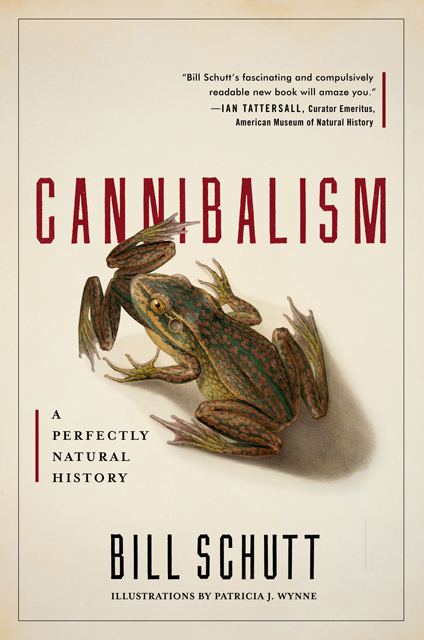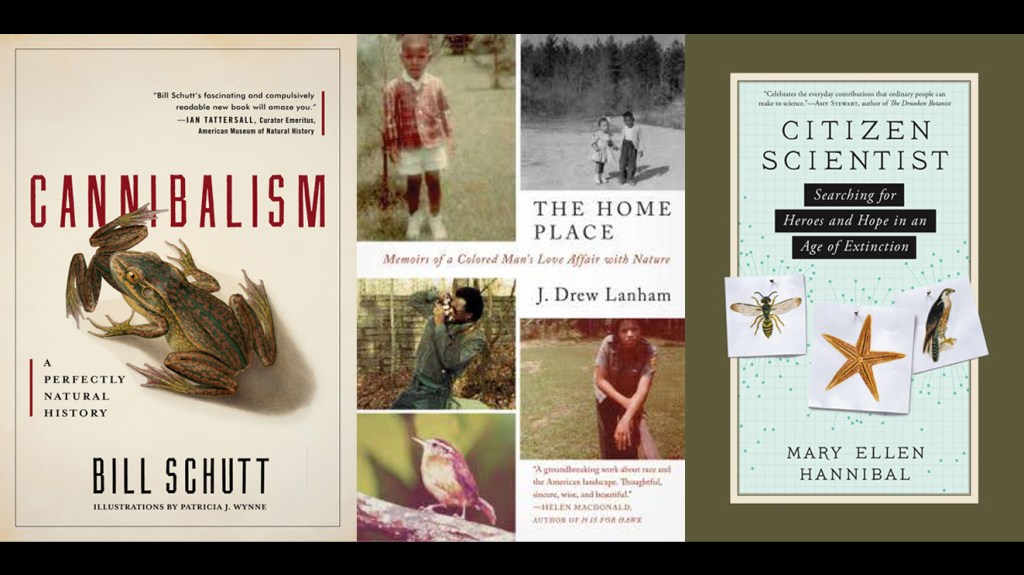Maybe you need a book for your journey to the March for Science. Maybe you’re looking for an enjoyable read to pack along on a spring campout. Maybe you just love good books.
Whatever the case, here are three excellent examples of what science storytelling can be, by three of the best science writers working today.
-
Cannibalism: A Perfectly Natural History
By Bill Schutt (Algonquin Books)

By turns funny and horrifying – but never sensationalistic – Cannibalism is another excellent work of science writing by zoologist Bill Schutt. Schutt previously wrote about blood-feeding creatures in his entertaining Dark Banquet, one of my favorite nature books. His latest, about a particularly nightmarish topic, doesn’t disappoint.
Schutt looks at cannibalism in other animals before turning attention to humans. He has fun with this material but always grounds it in the scientific literature. What you think you know about the mating habits of praying mantises, for instance, is probably based more on myth than fact. Polar bears eating their cubs has been trotted out as an effect of climate change, but in reality it is probably just bears doing what they’ve always been doing.
There are many reasons why an animal might dine on its own kind. But there’s a frequent pattern: When the going gets tough, the tough eat their own kind, humans most definitely not excepted. Schutt spends a lot of time looking at human cannibalism, including its causes, its taboos and its continuation into modern times. He skips the usual lurid tales of criminal cannibals, and focuses instead on what cannibalism means and why it matters. He explores the subject deeply, whether joining field archaeologists seeking evidence on what really happened with the Donner Party, or dining on placenta osso buco with sides (I consider myself an adventurous eater, but: no).
He also explores how rumors of cannibalism could be exaggerated or manufactured to justify horrific crimes against indigenous peoples, the consequences of feeding cows to cows, and why symbolic cannibalism (such as Christianity’s Holy Communion) continues to be a fairly common human ritual.
Cannibalism appears frequently in popular culture as a source of horror, and that may be why I’m seeing this book even in airport bookstores and bestseller racks. It’s a fun book, but don’t let that hide the fact that this is also science writing at its finest.
-
The Home Place
By J. Drew Lanham (Milkweed Editions)

There’s a persistent idea that scientists should not show emotion, as if straying from facts, from jargon, might cause others to take their science less seriously. I wish I could make all scientists who cling to this idea read J. Drew Lanham’s The Home Place, a memoir of a scientist unapologetically in love with nature and the land.
Lanham describes himself as a “rare bird, an oddity”: an African-American ornithologist who loves birding, hunting and exploring the land. His memoir explores the influences that led him to his land ethic and his career in science. It’s a story of family, of a rural childhood, of birds and academia and special places lost and found.
It’s a story, too, about race, about the reality of being an African-American field researcher in the rural South. He has to watch where he points his binoculars. Even tracing his family’s history becomes a complicated and often heartbreaking story. (You should also read his article, 9 Rules for the Black Birdwatcher).
The writing here is lyrical, beautiful, some of the best you’ll find on the land ethic and the outdoors. I found myself rereading passages and savoring them. The chapter on how he came to deer hunting is perhaps the best on the subject I’ve read in years (and I’ve read a lot about hunting).
Read it, enjoy it, pass it on. I hope we see more from Lanham in the near future.
-
Citizen Scientist
By Mary Ellen Hannibal (Workman Publishing)

One of the hottest trends in conservation science is the use of citizen science: the collected evidence of people sharing their observations. Whether it’s bird observations in your backyard or poring over thousands of camera trap images on your computer, you can contribute to scientific understanding – and help conservationists protect wildlife and ecosystems.
“Citizen science is taking off as never before, and it is needed as never before,” Mary Ellen Hannibal writes in the definitive book on the subject. “What does it take to save nature? How do we look at this gigantic problem [the extinction crisis]? Citizen science starts with and continuously returns to individual observations in nature.”
Unlike the other two authors reviewed here, Hannibal is not a scientist. But she is a gifted reporter with a curious mind. She knows the science and has spent extensive time in the field with scientists. And she has spent an equally extensive amount of time working on citizen science projects.
It shows. This is an expansive book, showing how anyone can make a huge difference, and demonstrating the real promise of citizen science in solving some of the world’s most pressing challenges. The scope is impressive, using concrete examples to illustrate bigger issues in science and conservation. The chapter on taxonomy and traditional natural history collections is alone worth the price of the book.




Thanks, Matt. I’ll present these to the Boulder TNC book group. The one on citizen science has me intrigued, especially since we’re continually trying to get that type of input regarding LANDFIRE products. Much obliged.